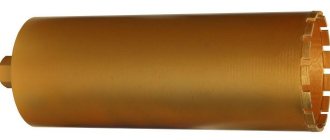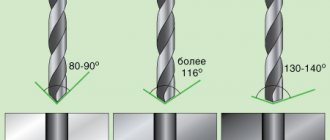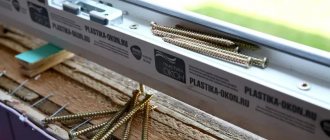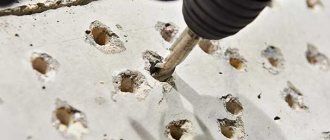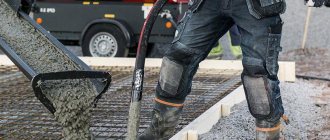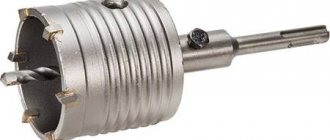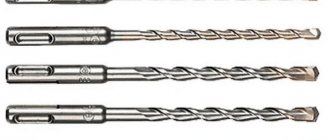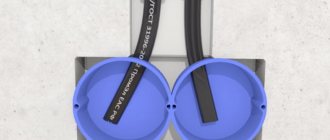If you need to drill a hole in the wall, then it is better to use a hammer drill, into the chuck of which you need to load a drill. However, if you don’t have a hammer drill, then you don’t need to buy this tool specifically for drilling concrete. A drill can also handle this. Just to drill a hole in a concrete wall, you will need a concrete drill bit for a drill. This is a special attachment that is installed in the collet chuck of the tool. They come in different types and designs, so before use, you need to understand their structure and application.
What is different about a concrete drill?
It has a special brazing made of a reliable alloy with a hardness level comparable to diamond. We are talking about victorious coating.
Equipment for drilling element for concrete:
- Can be used in conjunction with a drill. The design of the drill is distinguished by the presence of a tail with a cylindrical or multifaceted shape;
- For a hammer drill. It is made in a shape similar to a shank or cylinder. For marking, the inscription SDS PLUS or SDS MAX is used.
How to drill through reinforced concrete?
If you use an impact drill model for concrete based on reinforced concrete, then nothing will work. To do this, you will have to use a hammer drill with a special type of impact drill for concrete; it is also called a drill for this dense material.
Special drill for reinforced concrete:
- Screw type. They help create holes with increased depth;
- Twist drills. Help create large holes;
- Gentle views. Suitable for creating holes with a small diameter and shallow depth.
To use such drills based on an impact drill or hammer drill, you need to fix them in the drive part of the chuck.
To facilitate installation, the drill design has a thickening at the tip. We are talking about professional equipment. It allows you to create holes with a diameter of around 4 mm and up to 3 cm.
About the design of shanks
The types of nozzles under consideration are classified into two main types according to the shape of the shank:
- Cylindrical - these are the most common, and are designed directly for impact drills with collet keys or keyless chucks
- Hexagonal shapes - this shank on concrete drills has an identical design with bits for screwing and unscrewing fasteners. Such nozzles with hexagonal shanks have a diameter of no more than 8-10 mm, and why this is so, we will consider further
When drilling concrete, and especially reinforced concrete, the drill may stall (get stuck). Due to the special cylindrical design of the shank, when it jams, the nozzle rotates, eliminating overheating of the motor and licking of the gear teeth. When using drills with hexagonal shanks in a collet chuck, the possibility of them turning when jammed is eliminated. As a result of getting stuck, not only the tool, but also the person can suffer. This is why manufacturers do not produce concrete drills with a hexagonal shank for drills larger than 8-10 mm.
This is interesting!
Drills with hexagonal shanks can also be used in the design of screwdrivers, where the chucks have a special hexagonal shape of the landing splines. There are also devices with tapered shanks that are designed for drilling machines, but they are not suitable for drilling into walls.
Using a crown on concrete
If a particularly large hole with a large diameter is required, then the use of a core tool for working with concrete is beneficial. This device will help create a recess based on a diameter of 12 cm in high-strength materials.
Core drill options:
- Diamond modification. Outwardly it looks like a tube or crown fixed to a rod. Diamond coating has been added to the edges;
- Pobedit version. Manufactured as a nozzle. It has an identical structure. But instead of diamond coating, pobedite teeth are used.
A core drill for concrete is used when it is necessary to prepare a recess for mounting an outlet or switch.
Important: To select the right device and drill for working with reinforced concrete, it is necessary to take into account the density of the material and the required size, depth, width of the hole.
The diameter of the drill in the end may be around 4 - 12 mm or more with a length from 50 mm to 1,000 mm. Therefore, it is clear that to create a large hole, larger and longer drills are required for working with reinforced concrete.
How to choose a drill for concrete?
For example, a drill based on an impact drill can penetrate lightweight types of concrete: aerated concrete, foam concrete, expanded clay concrete. But there is a very important nuance. The model of the selected equipment must have the “impact drilling” function.
Thanks to this, it is possible to create holes in the considered type of solid material and the average level of concrete.
- But, if you need to create a hole in beams, columns, or tiled floors, such equipment will not be suitable, since in this case reinforcement is used on the inside of the material.
- To cope with this task, it is worth studying the capabilities of various hammer drills equipped with the appropriate drill. The problem is that a standard drill will not be able to provide the impact force to work with such material.
These points must be taken into account when choosing a device and drill to perform the job reliably.
Features of drills
In order to choose the right drill for concrete structures, without making mistakes, you will need to know the features that distinguish them from products for metal and other materials.
The shape of the working area will be quite blunt; this area is made of a Pobedit plate. This type is suitable for concrete as woodworking products will include sharp tips. Due to this, at the beginning of the work, the wood is stuck inside, and only then a hole is made. The working area of a metal product is similar to a cone with no sharp points.
The color of concrete products is often metallic white. Products for wood will be strictly metal, and for metal, black colors are used.
Recommendations for working with concrete
A quality choice of equipment and drill does not guarantee a positive result. You must be able to use the selected device correctly.
Helpful Tips:
- Before starting work, you should prepare the device and a set of drilling elements. It is important to realize that creating a hole with the required diameter requires the appropriate drill and equipment. Therefore, it is necessary to have different models to solve any problem;
- If during operation the drill hits the reinforcement, then it is beneficial to change the drill to a model for drilling metal. But this problem can be solved by pre-sharpening the drill. This way you don’t have to interrupt work to replace the drilling element;
- During operation, it is important to prevent the drill from overheating. Therefore, you should take a short break every 15 seconds. But for this you should use the natural cooling process. There is no need to pour water or other liquid over the drill, as it may become damaged;
- In the case of a meeting with a very hard stone, it is beneficial to have a chipper in your arsenal. It will help crush the obstacle to make room for the drill to work;
- It is not recommended to use an impact drill on a load-bearing wall or ceiling. It will not help in creating a hole with the required diameter and depth. In this case, it is more profitable to use a hammer drill;
- If you are making a hole in ceramics, then you should also use equipment for concrete. But with one difference, you need to turn off the shock mode, this will help maintain the integrity of the tile;
- If during operation the drill has noticeably deteriorated or become dull, then to restore factory characteristics it can be processed with a grinder in combination with a diamond disc. But when using an expensive and high-quality drill, such situations usually do not occur. Therefore, it is profitable to purchase professional equipment. It is more expensive, but there are fewer unexpected problems with it.
Now we understand how a drill for working with concrete differs and what equipment it is used with. We understood the advantages of a core drill for this hard material.
We looked at the aspects that need to be paid attention to in the process of choosing a drill and the corresponding device. To simplify the work process, many useful tips have been offered. Therefore, now we have enough information to create a hole based on this material.
What it is?
- Concrete drills are equipped with special brazing tips made from high-strength pobedite alloy, which is almost as hard as diamond.
- The pobedite tip, welded to the top of the drill, is an alloy of tungsten and cobalt with other chemical elements added .
- The strength of such products allows them to be successfully used when drilling structures made of hard materials.
Distinctive features
In order to determine when looking at a drill for concrete that this is exactly the option that is needed for working with high-strength structures, you should know its main features.
Tip type:
- wood drills have a sharp tip, which, when used, penetrates the surface of the material;
- products for drilling metal have a cone-shaped tip;
- Concrete drills are blunted at the end and equipped with a lamellar brazing made of Pobedit.
By color:
- black metallic color is typical for metal drills;
- products for drilling wood have a lighter metallic shade;
- white color is a sign of a concrete drill.
Kinds
- Drills for drilling concrete can be roughly classified based on two parameters: the diameter of the holes being drilled and the type of tool used.
- To make small-diameter holes, it is possible to use both impact drills and hammer drills, into which drills with T-shaped or cross-shaped tips are installed.
- Making large holes in concrete is done using diamond bits shaped like a cylinder.
Do you know how to properly tap a wall for wiring? Detailed instructions here.
Drill types:
- The most common type is products that are similar in shape and size to ordinary drills, but equipped with pobedite surfacing at the end.
- Another option is a drill bit . Such a tool can be designed to work with a drill or hammer drill. The drill with which the drill is equipped is equipped with a cylinder-shaped shank that allows it to be fixed in a jaw chuck.
- Drills for rotary hammers (marked SDS) are equipped with shanks with longitudinal grooves, due to which the drill is securely attached to a snap-on chuck. The thickness of the drill for an impact drill does not exceed 12 mm; hammer drill products can have a diameter of up to 3 cm, and make holes up to 1 m deep.
- Diamond core bits are used for larger holes (for example, when installing socket boxes or laying a pipeline). The crown consists of a steel cylinder and a rod attached to it (see photo), which is inserted into the chuck of a hammer drill or a special installation. Using the crown is quite convenient and simple.
Which ones are better to choose?
First of all, you should decide on the following criteria:
- depth and diameter of the proposed holes;
- the type of drilling tool used.
You should not give preference to cheap options, since drilling concrete strongholds requires the use of high-quality products.
It is better to opt for well-known foreign (Bosh, Metabo, Makita) or domestic (Zubr, Enkor, Interskol) manufacturers.
How to drill a concrete wall in an apartment?
If you need to drill holes less than 13 mm wide, you can use a conventional drill. To drill a larger hole, you will need a hammer drill.
The presence of an impact function increases the productivity of this tool, and the special design of the chuck, which allows you to quickly change the drill, makes it possible to reduce the time required to complete the job.
If you don’t have a hammer drill at hand, and the quality of the impact drill leaves much to be desired, then for drilling concrete walls it is better to use a carbide drill with asymmetric sharpening.
If you are thinking about whether it is possible to drill concrete with a screwdriver, then you should understand that not every model is suitable for such purposes. Here you will need a unit with the same hammer drill function, with a power of at least 1 kW.
But in any case, such a tool can hardly be used to perform any large-scale work.
How to drill through concrete with reinforcement?
The main part of the work on drilling reinforced concrete structures is performed using concrete drills. The drill is inserted into the drill (hammer) at a right angle, making sure that it fits into the chuck all the way.
If you hit the reinforcement during the drilling process, you can use special punches (if a hammer drill is involved in the work), which will help overcome the iron barrier . When using a drill to drill reinforcement, a simple metal drill will do.
During the work, the plaster on the other side of the wall may fall off . To avoid this phenomenon, you should set the tool to lower speeds.
If for some reason the drill gets stuck in the thickness of the wall, you should not try to pull it out by loosening the drill, as it can easily break .
article on how to properly lay tiles on walls.
As a result, the broken end will remain inside the wall. It is best to take a drill of a smaller diameter , with which you can drill out a stuck tool.
If drilling is performed with a non-professional tool, you should not use it for more than a quarter of an hour, taking a break for about the same period of time. Before resuming work, the drill should be moistened with water.
- Compliance with the above rules and instructions will allow you to avoid possible problems and save energy and nerve cells during drilling of a reinforced concrete stronghold.
- Watch the following video on how to drill through concrete:
Source: https://moistenki.ru/otdelka-vnutri/sverlo-po-betonu-dlya-dreli.html

